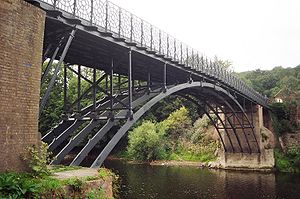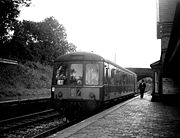
Preens Eddy
Encyclopedia
Location & Remains of the Settlement Today
Preens Eddy is a settlement which lies on the south bank of the River Severn between The Woodbridge Inn, just next to Coalport road bridge, and the settlement of The TuckiesThe Tuckies, Jackfield, Shropshire
The Tuckies is a hamlet in the eastern part of Jackfield, lying on the south bank of the River Severn, in the Ironbridge Gorge, and opposite the village of Coalport. The purpose of this article is to capture its historical importance during the industrial revolution and provide links to the people...
on the eastern edge of Jackfield where the Coalport Memorial Footbridge crosses the Severn. During the mid 20th Century, a further settlement, The Werps
The Werps, Jackfield, Shropshire
The lost village of Werps was one of a group of small settlements which later became collectively known as Jackfield in the Broseley Parish in Shropshire...
, separated Preens Eddy from The Tuckies
The Tuckies, Jackfield, Shropshire
The Tuckies is a hamlet in the eastern part of Jackfield, lying on the south bank of the River Severn, in the Ironbridge Gorge, and opposite the village of Coalport. The purpose of this article is to capture its historical importance during the industrial revolution and provide links to the people...
and The Werps will be considered as the western boundary Preens Eddy, the River Severn its northern boundary, the Woodbridge Inn its eastern boundary and the track of the old GWR railway line, its southern boundary. This means that the most notable landmark of Preens Eddy is the bridge over the Severn linking Broseley with Coalport, originally made of wood and hence called the "Wood Bridge", in contrast to its counterpart made of iron further upstream, famously known as the "Iron Bridge". The origin of name Preens Eddy (or Preen's Eddy) is unclear at the time of writing and contributions are sought to determine whether the Eddy is/was a swirling current formed by an obstruction in the river or whether Preen was a person, a place or a landmark/feature, or a name possibly linked to the Preenshead woodland location nearby.
Preens Eddy Bridge

1799–1818 - After the destruction of 1795, the bridge remained closed until the Trustees, of what was to become known as Coalport Bridge, had it rebuilt in 1799 as a hybrid of wood, brick and cast-iron parts, cast by John Onions (Proprietor’s Minute Book 1791–1827). The two original spans were removed
and replaced by a single span of three cast iron ribs, which sprang from the original outer sandstone pier bases. The bridge deck was further supported by two square brick piers, the northern one constructed directly on top of the stone pier base and the southern one set back slightly towards the river bank. The remainder of the superstructure was built of wood and may have reused some of the original beams. However by 1817, this bridge was failing again, attributed to the insufficient number of cast iron ribs, proving inadequate for the volume of traffic. Consequently, the bridge proprietors decided to rebuild Coalport Bridge once again, but this time chose to do so completely in iron.
1818–2005 - The date of 1818 displayed on its midspan panel refers to this substantial work which allowed the bridge, subscribed to by Charles Guest, one of the principal trustees, to stand without major repairs, for the next 187 years. John Onions and Guest's brother John, were buried at Birch Meadow Baptist Chapel, Broseley, a chapel which Guest had earlier paid half of the building costs. Some further strengthening work was carried out on the bridge in 2005 when it was closed for about one year to reconstruct the two brick arches supporting the verges at the south side of the bridge. Traffic control measures which previously limited traffic flow to single file were lifted and although weight is now limited to three tonnes, and a height restriction remains, the bridge is expected to continue to serve motor users in the gorge well into the 21st Century and maybe beyond.
Toll Houses
A detached Grade II Listed former Toll House, still sits on the bank of the River Severn, on the High Street, Coalport by Preens Eddy Bridge and was originally built for use as a warehouse between 1793 and 1808, after which it became used as a house by 1815 and as a Toll House from 1818. The tolls were collected by the Turnpike Commission trustees, representing the parishes who were responsible for the upkeep of the Coalport Road and locals used to call it the "catchgate" as it "caught you" to pay the toll. The building still has still contains the original spy holes at each side of the property so that the keeper could look out for people trying to use the road without paying a toll. An old photograph shows the toll gates adjacent to the property but permission has not yet been sought from the owner to use the photograph copyright in this article. In 1922, the bridge was freed from tolls but it is believed that even after cessation of tolls, the retired toll keeper, a Mr Green and his daughter who lived there, continued to protect the restore bridge by dissuading drivers of heavy vehicles from crossing.According to local historian, Ron Miles, there was also a stone riverside toll-house for boats entering the Gorge, on the riverside field next to the Severn Valley Way.
The Railway Station

The Bus Service
In 1963, a once-a-day bus was pictured at the Coalport Bridge Terminus. It was operated on Route 938 by Midland Red between Wellington and Coalport via Hadley. Coalport East railway station had already closed in 1958 and once Coalport West (Preens Eddy) closed in 1968, the bus & car remained as the only forms of transport for Coalport, having originally been well served by rail, road and river transport.The Woodbridge Inn
Today, the only remaining public house at Preens Eddy is The Woodbridge Inn, named after the original "Wood Bridge that crossed the Severn here. At postcode location TF8 7JF, its tranquil setting and good car parking attracts many who wish to explore Preens Eddy itself or take an easy walk around The WerpsThe Werps, Jackfield, Shropshire
The lost village of Werps was one of a group of small settlements which later became collectively known as Jackfield in the Broseley Parish in Shropshire...
, The Tuckies
The Tuckies, Jackfield, Shropshire
The Tuckies is a hamlet in the eastern part of Jackfield, lying on the south bank of the River Severn, in the Ironbridge Gorge, and opposite the village of Coalport. The purpose of this article is to capture its historical importance during the industrial revolution and provide links to the people...
, Jackfield, GWR Severn Valley Way, The Calcutts, The Hay Incline Plane and Coalport Basin, China works and Tile & Tar Tunnel museums with 5 or 6 pubs en-route.
Historical Houses nearby
The only sizable house of historical note appears to be The Amies, a rectangular, black-and-white building of Tudor styling, which was demolished in the 1890s. All that remains today are some depressions in the field and mentions of it in other articles about the larger Tuckies House located about a mile further west. There were numerous private and commercial relationships between inhabitants of The Amies House and The Tuckies House, both of which had significant impacts on land and business ownership in the Broseley, Coalport and Jackfield areas in general, in the 19th century.Preenshead Woodland
Preenshead is today and area of woodland, 4.8 hectares (12 acres) in size, adjacent to the Severn Valley Way (a former railway line and now a major walking and cycling route) on the south side of the river and heading westward from Coalport Bridge towards the village of Jackfield and the site of the lost village of The WerpsThe Werps, Jackfield, Shropshire
The lost village of Werps was one of a group of small settlements which later became collectively known as Jackfield in the Broseley Parish in Shropshire...
. Although the woodland itself is difficult to access, surrounding footpaths can be explored in some detail in the publication: Jackfield & Coalport: Five Historic Guided Walks by Michael Pooley.
Preenshead is a wood, purchased in 1997, but records show there has been woodland here for hundreds of years, clues to which are wild garlic (ramsons), wood anemones, bluebell and the rare wood barley. It is also home to a relatively high population of breeding bullfinch but despite its ancient pedigree, the wood today contains few trees more than 60 years old, caused by an almost complete felling of trees during the 1940s.

